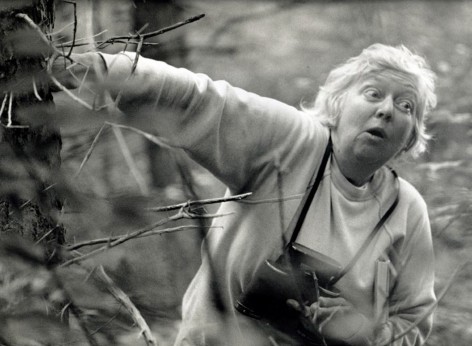Ginger Andrews

Edith Andrews in Nantucket’s State Forest reaching into a cavity containing recently hatched Saw-whet Owls. Photograph by Beverly Hall.
You have to go and look.
If you don’t look, you don’t see.
– Edith Andrews
Although I grew up completely immersed in birds, I didn’t actually become a birder until about ten or eleven years ago. Mom finally got me hooked while I was in what I called the preemptive chauffeuring stage—when her sight began to fail and she was looking through, rather than over, the steering wheel of her car. So all those birders whose kids aren’t into it, take hope. It took Edith 50 years, but she finally really set the hook!
With sadness for her passing and gratitude for so many years of her company, I want to share a few things about Edith that her birding friends and colleagues might not know.
Edith had many names in her lifetime: “Mom” to me; “Jean” to her family, gone long before her; and “Nan” to many. Doc Allen, at the Cornell Lab of Ornithology, christened her “Nan” because she talked so much about NANtucket.
Edith was a smoker for more than 25 years; she quit when the truth came out about cigarettes, and she never smoked at the Field Station.
During World War II, Edith was a spotter, watching for enemy planes from the windmill. She and her friend Grace Brown Gardner once reported the sound of a distant engine; it turned out to be a gas-powered lawnmower, an unusual luxury at the time.
My mother enjoyed target shooting, and was better at it than my father, who hunted to feed the family during the Depression.
As the daughter of a member of the Masonic lodge she belonged to the Order of the Eastern Star, where she took the part of Esther.
She loved going to the theatre, particularly musicals.
She was a good artist, making field sketches and occasionally painting.
Edith loved Nantucket as she loved birds. Whether they were alive or dead, injured or in distant flight, her motto was, “I never refuse a bird.” So many birds passed though her hands, including the Red-throated Loon that was one of my father’s courting gifts while she was preparing study skins at Cornell. It is still in the collection at the Maria Mitchell Association. And some 55,000 birds fell into her nets and were tagged with a small aluminum bracelet from the Bird Banding Office of United States Department of the Interior, aka "U.S. Fish and Wildlife Service."
Edith was a woman of strong passions; we all remember her enthusiasm, her love of life, her sheer excitement at a good bird—alive OR dead—a blooming plant, a butterfly, and the number of inflections she could give the word: “Really?”
My mother had a temper, though it was well controlled in public. Still, she found unique ways of expressing her disapproval. I remember once some people had caught an Evening Grosbeak and were keeping it as a pet. They proudly displayed it to us in a glass box so small it couldn’t even open its wings—this was before animal cruelty laws were enforced—and she pursed her mouth in distaste and said, “Well, can I have it for a specimen when it dies?” My father tried to hustle us out of there in a hurry.
Edith was the first and perhaps the only person on Nantucket (those were the John Birch Society days) to have a “Ban DDT” bumper sticker—bright orange with a skull and crossbones—proudly displayed on her car.
Edith was a hard scientist; she was stickler for details. She cared as lovingly for Maria Mitchell’s antiques as she did for living birds.
Many of these lived in the house with us. Once a garden club lady was visiting when a tern that was spending the winter with us instead of in Tierra del Fuego let loose a good-sized dropping on the Oriental rug. “Doesn’t that, er, BOTHER you, Edith?” the woman wanted to know. “Oh, no, it comes right up with the vacuum cleaner when it dries,” was the surprised reply. “Just a little whitewash.”
In so long and full a life there are always sorrows as well as joys. Edith’s early life was unhappy in many ways, and Nantucket in the 1950s was a hard place to earn a living. It was a big adjustment, after being on the faculty of a university, to become a housewife. But no matter what was going on, she always found it uplifting to see a bird. She was always ready to go out and look; “If you don’t look,” she would always say, “you don’t see.” Edith saw a lot. And she inspired others to look as well. And she kept on looking, retaining her interest almost to the end; she saw her last life bird, a Calliope Hummingbird, at age 98.
With great age there are many adjustments. Physical abilities diminish. There’s the transition from cane, to walker, to chair. The loss of hearing, diminishing vision, conversation condensed to a single word. But as energy ebbs and the body closes down, love remains, to the last breath. And after the last breath has been taken, that love still exists, in memory, our inspiration.
Ginger Andrews is Edith Andrews’ daughter. Ginger has set up two memorial funds in Edith’s name: the Edith Andrews Ornithology Scholarship Fund and the Edith Andrews Fund for Natural History and Ecology to support several local charities in their efforts to preserve, protect, and study Nantucket’s natural world. Both are administered through the Community Foundation for Nantucket: <https:> To donate, click on the “give now” button, select “select a fund” and Edith’s funds will appear in the list.</https:>